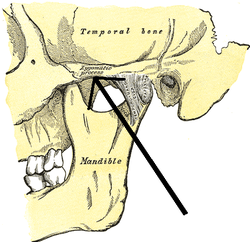Zygomatic arch
| Zygomatic arch | |
|---|---|
 Side view of the skull. | |
 Articulation of the mandible. Lateral aspect. | |
| Details | |
| Identifiers | |
| Latin | arcus zygomaticus |
| MeSH | D015050 |
| TA98 | A02.1.00.023 |
| TA2 | 427 |
| FMA | 53120 |
| Anatomical terminology | |
In anatomy, the zygomatic arch, or cheek bone, is a part of the skull formed by the zygomatic process of the temporal bone (a bone extending forward from the side of the skull, over the opening of the ear) and the temporal process of the zygomatic bone (the side of the cheekbone), the two being united by an oblique suture (the zygomaticotemporal suture);[1] the tendon of the temporal muscle passes medial to (i.e. through the middle of) the arch, to gain insertion into the coronoid process of the mandible (jawbone).
The jugal point is the point at the anterior (towards face) end of the upper border of the zygomatic arch where the masseteric and maxillary edges meet at an angle, and where it meets the process of the zygomatic bone.[clarification needed]
The arch is typical of Synapsida ("fused arch"), a clade of amniotes that includes mammals and their extinct relatives, such as Moschops and Dimetrodon.
Structure
The zygomatic process of the temporal arises by two roots:
- an anterior, directed inward in front of the mandibular fossa, where it expands to form the articular tubercle.
- a posterior, which runs backward above the external acoustic meatus and is continuous with the supramastoid crest.
The upper border of the arch gives attachment to the temporal fascia;[2] the lower border and medial surface give origin to the masseter.
Society and culture
High cheekbones are pronounced zygomatic arches, causing the upper part of the cheeks to jut out and form a line cut into the sides of the face. High cheekbones, forming a symmetrical face shape, are very common in fashion models and may be considered a beauty trait in both males and females within Eurocentric beauty standards.[3]
Etymology

The term zygomatic derives from the Greek ζύγωμα zygōma, meaning "bolt, bar", derived from ζυγο-, "yoke, join". The Greek word was already used with this anatomical sense by Galen (2.437, 746) in the 2nd century AD. The zygomatic arch is occasionally referred to as the zygoma, but this term usually refers to the zygomatic bone or occasionally the zygomatic process.
Other animals
The zygomatic arch is significant in evolutionary biology, as it is part of the structures derived from the ancestral single temporal fenestra of the synapsid ancestor of mammals.
Additional images
- Left temporal bone, outer surface
- Left zygomatic bone, malar surface
- Base of skull, inferior surface
- The temporalis; the zygomatic arch and masseter have been removed.
- Dissection, showing salivary glands of right side
- Fracture of the zygomatic arch as seen on plain X-ray
- Zygomatic arch, base of skull
See also
References
![]() This article incorporates text in the public domain from page 183 of the 20th edition of Gray's Anatomy (1918)
This article incorporates text in the public domain from page 183 of the 20th edition of Gray's Anatomy (1918)
- ^ Herring, Susan W.; Mucci, Robert J. (1991). "In vivo strain in cranial sutures: The zygomatic arch". Journal of Morphology. 207 (3): 225–239. doi:10.1002/jmor.1052070302. ISSN 0362-2525. PMC 2814820. PMID 1856873.
- ^ Abul-Hassan HS, von Drasek Ascher G, Acland RD (January 1986). "Surgical anatomy and blood supply of the fascial layers of the temporal region". Plastic and Reconstructive Surgery. 77 (1): 17–28. doi:10.1097/00006534-198601000-00004. PMID 3941846. S2CID 34872321.
- ^ Sex and Society. Marshall Cavendish. September 2009. p. 91. ISBN 978-0-7614-7906-2. Retrieved 2 November 2012.
External links
- Lesson1 at The Anatomy Lesson by Wesley Norman (Georgetown University) (latskullitems)
- "Anatomy diagram: 34257.000-1". Roche Lexicon – illustrated navigator. Elsevier. Archived from the original on 2012-07-22.







